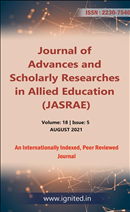The Marriage System in Modern Society as Exposed by the Women Moral and Spiritual Breakdown in Shobha De's Novels
Exploring the Impact of Marriage on Society through Shobha De's Novels
Keywords:
marriage system, modern society, women moral and spiritual breakdown, Shobha De's novels, biological definition, importance of marriage, human society, state recognition, church recognition, lifetime commitment, Sanskaras, sacraments, Hinduism, solemn contract, man and woman, Dharma, Artha, Kama, Moksha, social development, cultural development, earthly life, future improvement, next generationAbstract
The biological definition of marriage described in this article demonstrates the importance ofmarriage to human society regardless of whether or not it has been recognized by the state or the church.As a lifetime commitment between a woman and husband, marriage is considered one of the Sanskaras(sacraments) in India. Marriage in Hinduism is a solemn contract between a man and a woman in whichboth parties pledge to support one another in their pursuit of Dharma, Artha, Kama, and Moksha. Assuch, it affects the social and cultural development of society by providing access to the pleasures ofearthly life, the hope of future improvement, and the care of the next generation.Published
2021-08-01
How to Cite
[1]
“The Marriage System in Modern Society as Exposed by the Women Moral and Spiritual Breakdown in Shobha De’s Novels: Exploring the Impact of Marriage on Society through Shobha De’s Novels”, JASRAE, vol. 18, no. 5, pp. 432–436, Aug. 2021, Accessed: Jul. 03, 2024. [Online]. Available: https://ignited.in/jasrae/article/view/13502
Issue
Section
Articles
How to Cite
[1]
“The Marriage System in Modern Society as Exposed by the Women Moral and Spiritual Breakdown in Shobha De’s Novels: Exploring the Impact of Marriage on Society through Shobha De’s Novels”, JASRAE, vol. 18, no. 5, pp. 432–436, Aug. 2021, Accessed: Jul. 03, 2024. [Online]. Available: https://ignited.in/jasrae/article/view/13502








